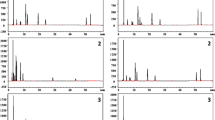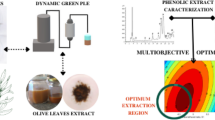Abstract
In the present study, a new method based on microwave-assisted extraction and dispersive liquid–liquid microextraction (MAE–DLLME) followed by high-performance liquid chromatography (HPLC) was proposed for the separation and determination of oleuropein (Ole) and hydroxytyrosol (HyT) from olive pomace samples. The effective factors in the MAE–DLLME process such as microwave power, extraction time, the type and volume of extraction, and dispersive solvents were studied and optimized with the aid of response surface methodology (RSM) based on a central composite design (CCD) to obtain the best condition for Ole and HyT extraction. At the optimized conditions, parameter values were 220 W microwave power, 12 min extraction time, 60 μL extracting solvent, and 500 μL dispersive solvent. The calibration graphs of the proposed method were linear in the range of 10–500,000 μg L−1, with the coefficient of determination (R2) higher than 0.99 for Ole and HyT. Repeatability of the method, described as the relative standard deviation (RSD), was 4.12–5.63% (n = 6). The limits of detection were 35 and 20 μg L−1 for Ole and HyT, respectively. The recoveries of these compounds in the spiked olive pomace sample were from 93 to 98%. The proposed method, MAE–DLLME–HPLC–UV, was an accurate, rapid, and reliable method when compared with previous methods.




Similar content being viewed by others

References
Aeenehvand S, Toudehrousta Z, Kamankesh M, Mashayekh M, Tavakoli HR, Mohammadi A (2016) Evaluation and application of microwave-assisted extraction and dispersive liquid–liquid microextraction followed by high-performance liquid chromatography for the determination of polar heterocyclic aromatic amines in hamburger patties. Food Chem 190:429–435
Ahmad-Qasem MH, Barrajón-Catalán E, Micol V, Mulet A, García-Pérez JV (2013) Influence of freezing and dehydration of olive leaves (var. Serrana) on extract composition and antioxidant potential. Food Res Int 50:189–196
Bashiry M, Mohammadi A, Hosseini H, Kamankesh M, Aeenehvand S, Mohammadi Z (2016) Application and optimization of microwave-assisted extraction and dispersive liquid–liquid microextraction followed by high-performance liquid chromatography for sensitive determination of polyamines in Turkey breast meat samples. Food Chem 190:1168–1173
Bener M, Özyürek M, Güçlü K, Apak R (2016) Optimization of microwave-assisted extraction of curcumin from Curcuma longa L. (Turmeric) and evaluation of antioxidant activity in multi-test systems. Rec Nat Prod 10:542
Dermeche S, Nadour M, Larroche C, Moulti-Mati F, Michaud P (2013) Olive mill wastes: biochemical characterizations and valorization strategies. Process Biochem 48:1532–1552
Farajzadeh MA, Asghari A, Feriduni B (2016) Development of a dispersive liquid–liquid microextraction method with a new sequence of steps and its comparison with a conventional method. J Sep Sci 39:3178–3185
Godoy-Caballero M, Acedo-Valenzuela M, Galeano-Diaz T (2013) New reversed phase dispersive liquid–liquid microextraction method for the determination of phenolic compounds in virgin olive oil by rapid resolution liquid chromathography with ultraviolet–visible and mass spectrometry detection. J Chromatogr A 1313:291–301
Gögüs F, Maskan M (2001) Drying of olive pomace by a combined microwave-fan assisted convection oven. Mol Nutr Food Res 45:129–132
Habibi H, Mohammadi A, Hoseini H, Mohammadi M, Azadniya E (2013) Headspace liquid-phase microextraction followed by gas chromatography–mass spectrometry for determination of furanic compounds in baby foods and method optimization using response surface methodology. Food Anal Method 6:1056–1064
Habibi H, Mohammadi A, Kamankesh M (2017) Hydroxymethylfurfural in fruit puree and juice: preconcentration and determination using microextraction method coupled with high-performance liquid chromatography and optimization by Box–Behnken design. J Food Meas Charact:1–9
Heleno SA, Diz P, Prieto M, Barros L, Rodrigues A, Barreiro MF, Ferreira IC (2016) Optimization of ultrasound-assisted extraction to obtain mycosterols from Agaricus bisporus L. by response surface methodology and comparison with conventional Soxhlet extraction. Food Chem 197:1054–1063
Japón-Luján R, Luque-Rodríguez J, De Castro ML (2006a) Dynamic ultrasound-assisted extraction of oleuropein and related biophenols from olive leaves. J Chromatogr A 1108:76–82
Japón-Luján R, Luque-Rodríguez J, De Castro ML (2006b) Multivariate optimisation of the microwave-assisted extraction of oleuropein and related biophenols from olive leaves. Anal Bioanal Chem 385:753–759
Kamankesh M, Mohammadi A, Hosseini H, Tehrani ZM (2015) Rapid determination of polycyclic aromatic hydrocarbons in grilled meat using microwave-assisted extraction and dispersive liquid–liquid microextraction coupled to gas chromatography–mass spectrometry. Meat Sci 103:61–67
Khajeh M, Ghanbari M (2011) Optimization of microwave-assisted extraction procedure to determine metal in fish muscles using Box–Behnken design. Food Anal Method 4:431–436
Kubo A, Lunde CS, Kubo I (1995) Antimicrobial activity of the olive oil flavor compounds. J Agr Food Chem 43:1629–1633
Le Tutour B, Guedon D (1992) Antioxidative activities of Olea europaea leaves and related phenolic compounds. Phytochemistry 31:1173–1178
Madani-Tonekaboni M, Kamankesh M, Mohammadi A (2015) Determination of furfural and hydroxymethyl furfural from baby formula using dispersive liquid–liquid microextraction coupled with high performance liquid chromatography and method optimization by response surface methodology. J Food Compos Anal 40:1–7
Malik NS, Bradford JM (2006) Changes in oleuropein levels during differentiation and development of floral buds in ‘Arbequina’ olives. Sci Hortic 110:274–278
Manna C, D'Angelo S, Migliardi V, Loffredi E, Mazzoni O, Morrica P, Galletti P, Zappia V (2002) Protective effect of the phenolic fraction from virgin olive oils against oxidative stress in human cells. J Agr Food Chem 50:6521–6526
Ortega-García F, Blanco S, Peinado MÁ, Peragón J (2008) Polyphenol oxidase and its relationship with oleuropein concentration in fruits and leaves of olive (Olea europaea) cv. ‘Picual’ trees during fruit ripening. Tree Physiol 28:45–54
Pérez-Serradilla J, Japon-Lujan R, de Castro ML (2007) Simultaneous microwave-assisted solid–liquid extraction of polar and nonpolar compounds from alperujo. Anal Chim Acta 602:82–88
Pizarro ML, Becerra M, Sayago A, Beltrán M, Beltrán R (2013) Comparison of different extraction methods to determine phenolic compounds in virgin olive oil. Food Anal Method 6:123–132
Priego-Capote F, Ruiz-Jiménez J, de Castro ML (2004) Fast separation and determination of phenolic compounds by capillary electrophoresis–diode array detection: application to the characterisation of alperujo after ultrasound-assisted extraction. J Chromatogr A 1045:239–246
Ramezani H, Hosseini H, Kamankesh M, Ghasemzadeh-Mohammadi V, Mohammadi A (2015) Rapid determination of nitrosamines in sausage and salami using microwave-assisted extraction and dispersive liquid–liquid microextraction followed by gas chromatography–mass spectrometry. Eur Food Res Technol 240:441–450
Reboredo-Rodríguez P, Rey-Salgueiro L, Regueiro J, González-Barreiro C, Cancho-Grande B, Simal-Gándara J (2014) Ultrasound-assisted emulsification–microextraction for the determination of phenolic compounds in olive oils. Food Chem 150:128–136
Rezaee M, Assadi Y, Hosseini M-RM, Aghaee E, Ahmadi F, Berijani S (2006) Determination of organic compounds in water using dispersive liquid–liquid microextraction. J Chromatogr A 1116:1–9
Rodrigues F, Pimentel FB, Oliveira MBP (2015) Olive by-products: challenge application in cosmetic industry. Ind Crop Prod 70:116–124
Rombaut N, Tixier AS, Bily A, Chemat F (2014) Green extraction processes of natural products as tools for biorefinery. Biofuels Bioprod Biorefin 8:530–544
Romero-García J, Niño L, Martínez-Patiño C, Álvarez C, Castro E, Negro M (2014) Biorefinery based on olive biomass. State of the art and future trends. Bioresour Technol 159:421–432
Sereshti H, Ahmadvand M, Asgari S (2014) A rapid quantification of β-carotene in fruits and vegetables by dispersive liquid–liquid microextraction coupled with UV–vis spectrophotometry: optimized by response surface methodology. Food Anal Method 7:1481–1488
Tripoli E, Giammanco M, Tabacchi G, Di Majo D, Giammanco S, La Guardia M (2005) The phenolic compounds of olive oil: structure, biological activity and beneficial effects on human health. Nutr Res Rev 18:98–112
Vilaplana-Pérez C, Auñón D, García-Flores LA, Gil-Izquierdo A (2014) Hydroxytyrosol and potential uses in cardiovascular diseases, cancer, and AIDS. Front Nutr 1:1–11
Yang P et al (2017) Dispersive liquid-liquid microextraction method for HPLC determination of phenolic compounds in wine. Food Anal Method:1–15
Acknowledgements
This study has been supported by the Faculty of Nutrition Sciences and Food Technology, Shahid Beheshti University of Medical Sciences, Tehran, Iran. We gratefully appreciate their assistance. We also appreciate the “Student Research Committee” and “Research & Technology Chancellor” of Shahid Beheshti University of Medical Sciences for their support of project NO 1395/78295 from the Student Research Committee, Shahid Beheshti University of Medical Sciences, Tehran, Iran.
Author information
Authors and Affiliations
Corresponding author
Ethics declarations
Conflict of Interest
Hossein Habibi declares that he has no conflict of interest. Abdorreza Mohammadi declares that he has no conflict of interest. Mehdi Farhoodi declares that he has no conflict of interest. Sahar Jazaeri declares that she has no conflict of interest.
Ethical Approval
This article does not contain any studies with human participants or animal performed by any of the authors.
Rights and permissions
About this article
Cite this article
Habibi, H., Mohammadi, A., Farhoodi, M. et al. Application and Optimization of Microwave-Assisted Extraction and Dispersive Liquid–Liquid Microextraction Followed by High-Performance Liquid Chromatography for the Determination of Oleuropein and Hydroxytyrosol in Olive Pomace. Food Anal. Methods 11, 3078–3088 (2018). https://doi.org/10.1007/s12161-018-1279-x
Received:
Accepted:
Published:
Issue Date:
DOI: https://doi.org/10.1007/s12161-018-1279-x



